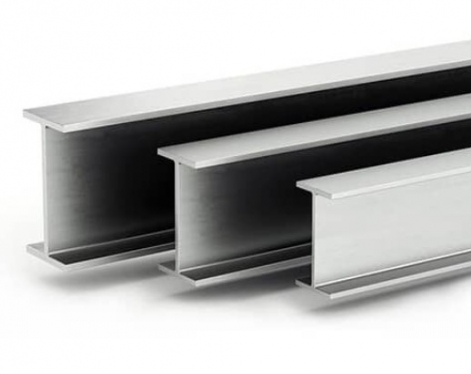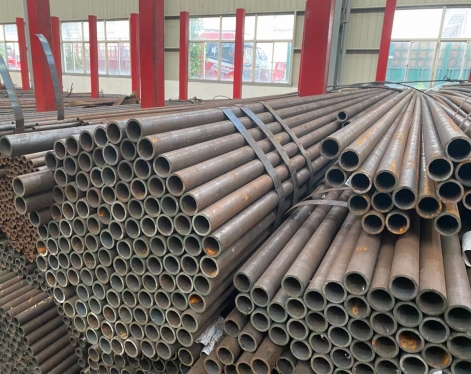H-beams, so called because their cross-section resembles the letter 'H', are a cost-effective and high-performance structural steel shape. The reason why H-beam can be widely used in many fields is closely related to its own performance. However, H-beam obtained by conventional production process has certain limitations in performance and cannot fully meet the increasingly stringent use requirements of various industries. At this time, heat treatment process is particularly important, which can optimize and improve the performance of H-beam and tap more potential of H-beam.
Detailed explanation of heat treatment process steps
Quenching: Improve hardness and strength
Quenching is a key step in the heat treatment process of H-beam. In the specific operation, the H-beam is first heated to above the critical temperature to allow its internal structure to fully transform into austenite. Then, it is cooled at an extremely fast speed to quickly transform the austenite into hard and brittle structures such as martensite or bainite. This process is like injecting "tough power" into the H-beam, significantly improving its hardness and strength.
Tempering: Improve overall performance
Tempering usually follows quenching. After quenching, there is a large stress inside the H-beam and the structure is brittle. At this time, tempering is needed to "reconcile". Tempering is to reheat the quenched H-beam to a specific temperature, generally below the critical temperature, and then keep it warm for a period of time and finally cool it. Through tempering, the internal stress generated during the quenching process can be effectively eliminated, the brittleness of the material can be reduced, the toughness and plasticity can be improved, and the comprehensive mechanical properties of the H-beam can be improved.
Normalizing: Refining grains
Normalizing is the process of heating H-beam to above the critical temperature, keeping it warm for a suitable period of time, and then cooling it naturally in the air. Normalizing can refine the grains of H-beam and make the structure more uniform. This not only helps to improve the strength and toughness of H-beam, but also improves its cutting performance, providing a good foundation for subsequent processing and manufacturing.

Advantages of heat treatment process
Heat treating H-beams dramatically improves their performance, making them ideal for a wide range of applications.
From the perspective of mechanical properties, heat treatment can significantly improve the strength, hardness and toughness of H-shaped steel. In the construction field, the improvement of strength and toughness allows H-shaped steel to withstand great pressure and impact more easily. In the machinery manufacturing industry, the increase in hardness makes the mechanical parts made of H-shaped steel more wear-resistant. They can still maintain good working conditions under high-speed operation and frequent friction environments, extending the service life of the parts and reducing the maintenance cost of the equipment.
In terms of corrosion resistance, the heat treatment process also plays a positive role, improving its corrosion resistance by changing the internal organizational structure of H-beam. In marine engineering, H-beam is in a harsh environment of high humidity and high salt for a long time, and is extremely susceptible to corrosion. Heat-treated H-beam, with its excellent corrosion resistance, can effectively resist the erosion of seawater, ensure the long-term stable operation of facilities such as offshore platforms and cross-sea bridges, reduce structural damage and safety hazards caused by corrosion, and reduce maintenance and replacement costs.
Conclusion
The heat treatment process of H-beam has greatly improved the strength, hardness, toughness and corrosion resistance of H-beam through key steps such as quenching, tempering and normalizing, meeting the stringent requirements of many fields such as construction, machinery manufacturing and marine engineering. With the continuous development of various industries, the requirements for the performance of H-beam will become higher and higher. Relevant industries should attach great importance to the heat treatment process of H-beam, continuously optimize the process parameters, explore innovative process methods, fully tap the performance potential of H-beam, and provide better material support for the development of various fields.
Read more: Production Process of H Beams
Detailed explanation of heat treatment process steps
Quenching: Improve hardness and strength
Quenching is a key step in the heat treatment process of H-beam. In the specific operation, the H-beam is first heated to above the critical temperature to allow its internal structure to fully transform into austenite. Then, it is cooled at an extremely fast speed to quickly transform the austenite into hard and brittle structures such as martensite or bainite. This process is like injecting "tough power" into the H-beam, significantly improving its hardness and strength.
Tempering: Improve overall performance
Tempering usually follows quenching. After quenching, there is a large stress inside the H-beam and the structure is brittle. At this time, tempering is needed to "reconcile". Tempering is to reheat the quenched H-beam to a specific temperature, generally below the critical temperature, and then keep it warm for a period of time and finally cool it. Through tempering, the internal stress generated during the quenching process can be effectively eliminated, the brittleness of the material can be reduced, the toughness and plasticity can be improved, and the comprehensive mechanical properties of the H-beam can be improved.
Normalizing: Refining grains
Normalizing is the process of heating H-beam to above the critical temperature, keeping it warm for a suitable period of time, and then cooling it naturally in the air. Normalizing can refine the grains of H-beam and make the structure more uniform. This not only helps to improve the strength and toughness of H-beam, but also improves its cutting performance, providing a good foundation for subsequent processing and manufacturing.

Advantages of heat treatment process
Heat treating H-beams dramatically improves their performance, making them ideal for a wide range of applications.
From the perspective of mechanical properties, heat treatment can significantly improve the strength, hardness and toughness of H-shaped steel. In the construction field, the improvement of strength and toughness allows H-shaped steel to withstand great pressure and impact more easily. In the machinery manufacturing industry, the increase in hardness makes the mechanical parts made of H-shaped steel more wear-resistant. They can still maintain good working conditions under high-speed operation and frequent friction environments, extending the service life of the parts and reducing the maintenance cost of the equipment.
In terms of corrosion resistance, the heat treatment process also plays a positive role, improving its corrosion resistance by changing the internal organizational structure of H-beam. In marine engineering, H-beam is in a harsh environment of high humidity and high salt for a long time, and is extremely susceptible to corrosion. Heat-treated H-beam, with its excellent corrosion resistance, can effectively resist the erosion of seawater, ensure the long-term stable operation of facilities such as offshore platforms and cross-sea bridges, reduce structural damage and safety hazards caused by corrosion, and reduce maintenance and replacement costs.
Conclusion
The heat treatment process of H-beam has greatly improved the strength, hardness, toughness and corrosion resistance of H-beam through key steps such as quenching, tempering and normalizing, meeting the stringent requirements of many fields such as construction, machinery manufacturing and marine engineering. With the continuous development of various industries, the requirements for the performance of H-beam will become higher and higher. Relevant industries should attach great importance to the heat treatment process of H-beam, continuously optimize the process parameters, explore innovative process methods, fully tap the performance potential of H-beam, and provide better material support for the development of various fields.
Read more: Production Process of H Beams









